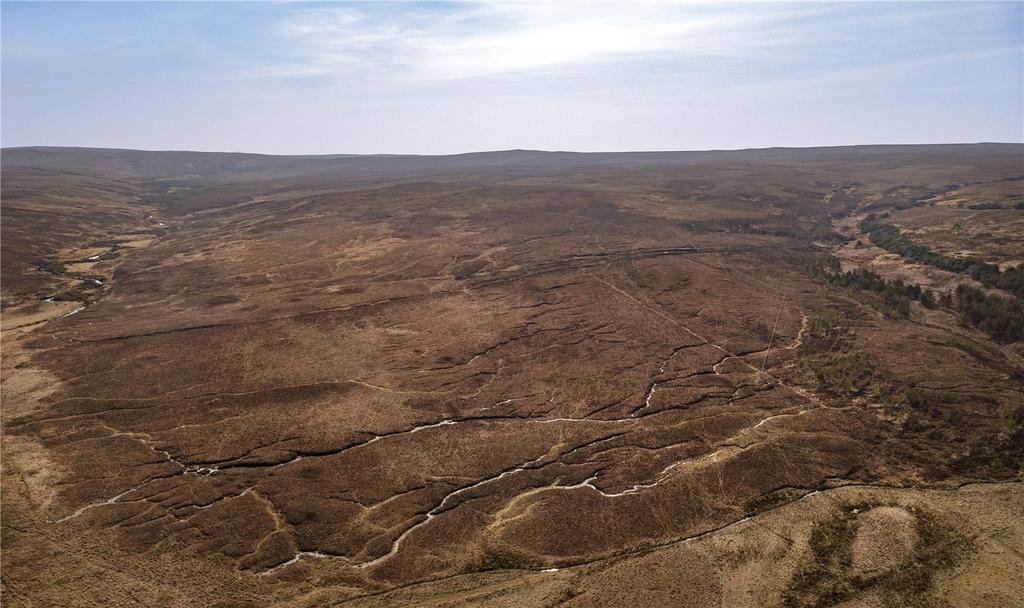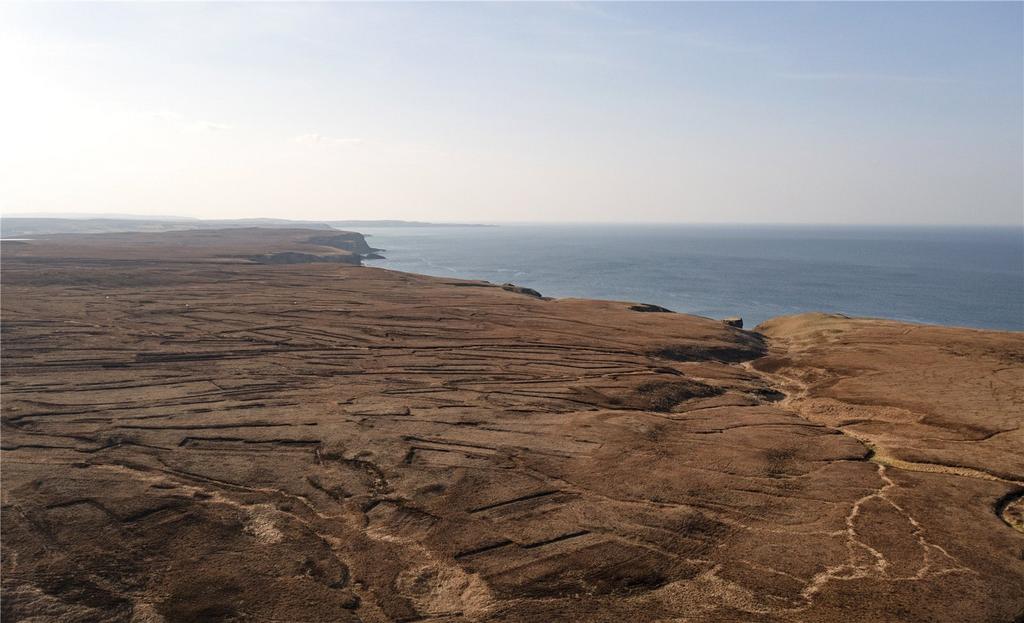Land
Featured
Land
8,137.00 acre(s)
Key information
Tenure: Freehold
Council tax: Ask agent
Features and description
- Coastal Estate with Natural Capital Potential
- Historic stone harbour, net store and bothy
- Approved woodland creation scheme (103 acres)
- Funding for peatland restoration (708 acres)
- Deer stalking, trout fishing and walked up grouse
- 3 bedroom cottage available in addition
- For sale as a whole or in two lots
- About 8,137 acres in total
Video tours
COASTAL ESTATE WITH DIVERSE NATURAL CAPITAL POTENTIAL
PROJECTED EMISSION REDUCTION 153,209 tCO2e (November 2022 assessment, Caledonian Climate)
Description
Sandside extends to about 8,137 acres in total and comprises around 2.75 miles of coastline and sea cliffs, open moorland, woodland, peatland, hill lochs and burns.
The coastline which forms the northern boundary of Sandside is made up of a spectacular series of sea cliffs, coves and inlets which command fantastic views out over the Atlantic Ocean, and are teeming with remarkable bird life.
The majority of Sandside is located to the south of the public road and the village of Reay, with the hill of Beinn Ratha forming a prominent ridge lying between the Sandside Burn and Brackside Burn, and a series of saddles and peaks along the southern and western boundaries of the estate.
Peatland Restoration
The vast majority of the underlying land at Sandside is blanket bog, made up of nationally important Class 1 carbon-rich soils, deep peat and priority peatland habitat of high conservation value. Surveys carried out by Caledonian Climate () have identified an initial area of some 707 acres (286 hectares) of peatland that has become degraded and could be restored to protect this vital carbon sink.
The proposed initial restoration project at Sandside is forecast to result in projected emissions reductions of 49,587 tonnes of carbon dioxide over the 100 year lifetime of the project, producing the same number of Peatland Carbon Units which can be sold or used to offset other business emissions.
The project is registered under the Peatland Code on the UK Land Carbon Registry, and PeatlandACTION grant funding has been secured for 2022/23 restoration works. This will enable a purchaser to commence this project at the earliest opportunity.
Woodlands
The existing woodlands at Sandside extend to about 391 acres (158 hectares) in total, with areas of mature trees interspersed with planting and natural regeneration projects carried out in the early 2000’s.
A further area of new native woodland planting has been identified with a Scottish Forestry Grant Scheme application recently approved. Extending to about 103 acres (42 hectares), the planting is designed to be fragmented and variable in density, with its primary purpose being to create a
rare peat edge woodland that will form the missing link in the natural transition between peatland and riparian habitats, and will seek to improve the water quality of the Sandside burn. It is estimated that this woodland creation project could deliver upwards of 13,500 tonnes of carbon equivalent (CO2e) sequestration over a 100 year project period,
delivering the same number of Woodland Carbon Units.
Sporting
The gently undulating nature of the hill combined with a
number of steep burns and gullies make for challenging and
exciting red deer stalking. Typically around 13 to 15 stags and 35 hinds have been taken each year, with much of the sport enjoyed by the current owners or with a local self-employed professional stalker who has an excellent knowledge of the ground employed to accompany and guide paying guests.
The moor has not been managed for grouse under the
current ownership but walked up shooting over pointers has
taken place occasionally, and most recently in 2022 when
encouraging number of grouse were seen. Historic bags are
not available but the remains of lines of butts from when
Sandside was formerly a driven moor can still be seen.
There are five hill lochs on Sandside which offer remote and
exciting fishing in spectacular surroundings for hard fighting
wild brown trout. Through the autumn and early winter
months these lochs can provide spectacular wildfowling for
ducks and geese, with wooden hides constructed around
Loch Hollistan for this purpose.
Location
Sandside is situated on the north coast of Scotland between John O’ Groats and Tongue about 12 miles to the west of Thurso.
Steeped in history Caithness is known for big skies, spectacular sea cliffs, wild and empty beaches, and long summer nights.
Thurso provides a wide range of facilities and professional services, supermarkets, a hospital, the University of the Highlands and Islands, and primary and secondary education.
The Northerly tip of the Scottish mainland is known for providing consistent and quality waves and the town of Thurso is a world-class destination for surfers.
Opportunities for coastal walks, hill walking and cycling are almost endless, and for golfers there is a fine mix of courses: Wick, Reay and Thurso, all 18 holes, and Lybster with 9 holes.
Acreage: 8137 Acres
Directions
From Thurso, continue west on the A836 to Reay, approximately 11 miles. After passing Reay Golf Club on the
right, continue through the village, and the estate ground lies either side of the A836.
Alternatively, from the A9 at Helmsdale take the A897 to Melvich, turning right (east) at the T-junction with the A836. Sandside Estate begins at the ‘Welcome to Caithness’ sign which defines the county march with Sutherland.
PROJECTED EMISSION REDUCTION 153,209 tCO2e (November 2022 assessment, Caledonian Climate)
Description
Sandside extends to about 8,137 acres in total and comprises around 2.75 miles of coastline and sea cliffs, open moorland, woodland, peatland, hill lochs and burns.
The coastline which forms the northern boundary of Sandside is made up of a spectacular series of sea cliffs, coves and inlets which command fantastic views out over the Atlantic Ocean, and are teeming with remarkable bird life.
The majority of Sandside is located to the south of the public road and the village of Reay, with the hill of Beinn Ratha forming a prominent ridge lying between the Sandside Burn and Brackside Burn, and a series of saddles and peaks along the southern and western boundaries of the estate.
Peatland Restoration
The vast majority of the underlying land at Sandside is blanket bog, made up of nationally important Class 1 carbon-rich soils, deep peat and priority peatland habitat of high conservation value. Surveys carried out by Caledonian Climate () have identified an initial area of some 707 acres (286 hectares) of peatland that has become degraded and could be restored to protect this vital carbon sink.
The proposed initial restoration project at Sandside is forecast to result in projected emissions reductions of 49,587 tonnes of carbon dioxide over the 100 year lifetime of the project, producing the same number of Peatland Carbon Units which can be sold or used to offset other business emissions.
The project is registered under the Peatland Code on the UK Land Carbon Registry, and PeatlandACTION grant funding has been secured for 2022/23 restoration works. This will enable a purchaser to commence this project at the earliest opportunity.
Woodlands
The existing woodlands at Sandside extend to about 391 acres (158 hectares) in total, with areas of mature trees interspersed with planting and natural regeneration projects carried out in the early 2000’s.
A further area of new native woodland planting has been identified with a Scottish Forestry Grant Scheme application recently approved. Extending to about 103 acres (42 hectares), the planting is designed to be fragmented and variable in density, with its primary purpose being to create a
rare peat edge woodland that will form the missing link in the natural transition between peatland and riparian habitats, and will seek to improve the water quality of the Sandside burn. It is estimated that this woodland creation project could deliver upwards of 13,500 tonnes of carbon equivalent (CO2e) sequestration over a 100 year project period,
delivering the same number of Woodland Carbon Units.
Sporting
The gently undulating nature of the hill combined with a
number of steep burns and gullies make for challenging and
exciting red deer stalking. Typically around 13 to 15 stags and 35 hinds have been taken each year, with much of the sport enjoyed by the current owners or with a local self-employed professional stalker who has an excellent knowledge of the ground employed to accompany and guide paying guests.
The moor has not been managed for grouse under the
current ownership but walked up shooting over pointers has
taken place occasionally, and most recently in 2022 when
encouraging number of grouse were seen. Historic bags are
not available but the remains of lines of butts from when
Sandside was formerly a driven moor can still be seen.
There are five hill lochs on Sandside which offer remote and
exciting fishing in spectacular surroundings for hard fighting
wild brown trout. Through the autumn and early winter
months these lochs can provide spectacular wildfowling for
ducks and geese, with wooden hides constructed around
Loch Hollistan for this purpose.
Location
Sandside is situated on the north coast of Scotland between John O’ Groats and Tongue about 12 miles to the west of Thurso.
Steeped in history Caithness is known for big skies, spectacular sea cliffs, wild and empty beaches, and long summer nights.
Thurso provides a wide range of facilities and professional services, supermarkets, a hospital, the University of the Highlands and Islands, and primary and secondary education.
The Northerly tip of the Scottish mainland is known for providing consistent and quality waves and the town of Thurso is a world-class destination for surfers.
Opportunities for coastal walks, hill walking and cycling are almost endless, and for golfers there is a fine mix of courses: Wick, Reay and Thurso, all 18 holes, and Lybster with 9 holes.
Acreage: 8137 Acres
Directions
From Thurso, continue west on the A836 to Reay, approximately 11 miles. After passing Reay Golf Club on the
right, continue through the village, and the estate ground lies either side of the A836.
Alternatively, from the A9 at Helmsdale take the A897 to Melvich, turning right (east) at the T-junction with the A836. Sandside Estate begins at the ‘Welcome to Caithness’ sign which defines the county march with Sutherland.
About this agent

It pays to specialise in a property market as broad as the one served by Savills Edinburgh. From prime commercial offices and out of town retail parks to the cream of city property, to country houses and sporting estates, the choice is as large and varied as the area we cover. That’s why we have dedicated teams specialising in prime residential property, farms and estates, land sales, commercial property, valuation and planning, right across the full property spectrum.










